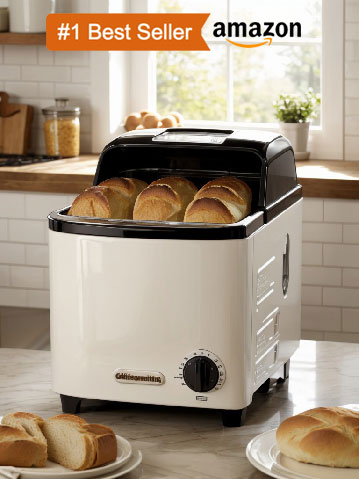Active Dry Yeast Vs Rapid Rise Yeast Bread Machine
Yeast is an important ingredient when it comes to baking bread, as it helps the dough to rise. Active dry yeast and rapid rise yeast are two of the most commonly used types of yeast in baking. These two yeasts are often used in a bread machine, and each has its own unique properties that can affect the texture and taste of the final product. Understanding the differences between active dry yeast and rapid rise yeast is essential for achieving the desired results when using a bread machine.

Active dry yeast is the most traditional type of yeast used for bread-making and is usually sold in small packets or jars. Rapid rise yeast is a newer type of yeast which is specifically designed for use in bread machines.
Active dry yeast is a type of yeast used in bread-making that has been around for many years. It is usually sold in small packets or jars, and can be found in most grocery stores, specialty baking stores, and online. Active dry yeast needs to be mixed with warm water and allowed to dissolve and activate before adding it to the bread dough.
Once activated, active dry yeast will begin to feed on the sugar in the dough and produce the carbon dioxide and alcohol that are essential for leavening the bread. This process can take anywhere from two to five hours until the dough has risen enough. Rapid rise yeast is a newer type of yeast specifically designed for use in bread machines. It is much less time-consuming than active dry yeast as it requires no activation time and begins to feed on the sugars in the dough almost immediately. This faster leavening process allows for bread to rise in about half the time of active dry yeast. Rapid rise yeast can be found in most grocery stores, specialty baking stores, and online.
Active dry yeast should be dissolved in warm water before being added to the other ingredients in the bread machine. Rapid rise yeast does not need to be dissolved in water and can be added directly to the other ingredients.
Active dry yeast is a common ingredient in bread machines and should be dissolved in warm water before being added to the other ingredients. Dissolving the yeast in warm water helps activate it, allowing it to help the dough rise. The ideal temperature for dissolving the yeast is between 105-115°F, to avoid killing the yeast.
To dissolve the yeast, mix it with a small amount of sugar and warm water and let it sit for about 10 minutes until it becomes foamy. Once the yeast is dissolved, add it to the other ingredients and select the correct setting on your bread machine. Rapid rise yeast, on the other hand, does not need to be dissolved in water and can be added directly to the other ingredients in the bread machine. This type of yeast is pre-activated, meaning it can help the dough rise faster. It is important to note, however, that rapid rise yeast should not be used in place of active dry yeast in recipes that call for active dry yeast.
See also: Pumpkin Bread Using Express Bake Of A Bread Machine
Active dry yeast takes longer to rise and can take up to two hours to double in size, while rapid rise yeast only takes one hour to double in size.
Active dry yeast is a type of yeast that is particularly useful for bread baking. It is the traditional type of yeast and is the most widely used form of yeast in home baking. It is a slow-acting, granular yeast that needs to be rehydrated before use.
Active dry yeast takes longer to rise than rapid rise yeast, as it can take up to two hours to double in size. In comparison, rapid rise yeast is specially formulated to reduce rising time and only takes one hour to double in size. This makes rapid rise yeast more convenient and suitable for recipes that require a shorter rise time. Active dry yeast is especially useful for doughs that require a long, slow rise, such as pizza dough or sourdough bread, as it provides a richer taste and texture.
See also: Bread Machine Recipie Allrecipieshttps Www Yahoo Com Fr Yset_Chr_Syc_Hp
Active dry yeast can be used in a bread machine, but it will take longer for the dough to rise and the end result may not be as light and fluffy as it would be using rapid rise yeast.
Active dry yeast is an ideal choice for baking bread in a bread machine. While it will take a bit longer to rise than rapid rise yeast, the results are still satisfactory. To get the most out of using active dry yeast, it should be re-hydrated prior to use.
To do this, combine the yeast with warm water (about 105 to 115 degrees Fahrenheit) and a pinch of sugar, and let stand for about 10 minutes before adding it to the bread machine. The dough will take longer to rise than when using rapid rise yeast, but with patience, the bread will still be light and fluffy. It is important to remember that the temperature of the water is important when re-hydrating the yeast, as too hot or too cold can kill it, resulting in bread that doesn't rise. When using active dry yeast in a bread machine, it is best to follow the instructions of the machine itself for optimal results.
See also: Simple Banana Bread In Bread Machine Using Breadmix
Rapid rise yeast is more expensive than active dry yeast.
Rapid rise yeast is a type of active dry yeast, but with added enzymes which helps to reduce the time for rising. The addition of enzymes also improves the flavor of the dough, allowing for a lighter texture in quick breads and pizza crusts. Rapid rise yeast is more expensive than regular active dry yeast because the additional enzymes are more costly to produce.
This type of yeast is usually sold in small packets, and should be used within 4 months of purchase for best results. When using rapid rise yeast, it can be added directly to the dry ingredients without the need for proofing or dissolving in water first. The rising time is significantly reduced compared to regular active dry yeast, often taking as little as half the time for breads, rolls and pizza doughs. Although it is more costly, the convenience of rapid rise yeast can be invaluable for busy bakers.
See also: Can You Makr German Black Bread In A Bread Machine
Rapid rise yeast should not be used with recipes that require a long rise time, as it will cause the dough to over-proof and result in a dense and heavy loaf of bread.
Rapid rise yeast, also known as bread machine yeast, is a type of yeast that is most commonly used in bread machines. It is a highly active strain of yeast that allows for faster rising and shorter overall rising times than traditional active dry yeast. While this can be useful for time-sensitive recipes, it is not suitable for recipes that require a long rise time.
Rapid rise yeast will cause the dough to over-proof and result in a dense, heavy loaf of bread. If you are using a recipe that requires a long rise time, it is best to use traditional active dry yeast instead. Additionally, it is important to follow the recipe precisely to ensure optimal results. This includes measuring the ingredients accurately and ensuring that the dough is kneaded for the appropriate amount of time before allowing it to rise. By following these steps and using the correct type of yeast, you can bake a delicious loaf of bread.
See also: Can I Leave Bread In The Bread Machine Overnight
Active dry yeast can be stored in an airtight container in the refrigerator for up to one year, while rapid rise yeast should be stored in a cool, dry place and used within six months.
Active dry yeast is a great option for baking and can be stored in an airtight container in the refrigerator for up to a year. This type of yeast requires rehydration before use and is ideal for recipes that use a long fermentation process. Rapid rise yeast, on the other hand, is pre-hydrated and ready to use, making it ideal for quick recipes or when time is of the essence.
Rapid rise yeast should be stored in a cool, dry place and used within 6 months of opening. It is important to note that both active dry yeast and rapid rise yeast have expiration dates, so it is important to check the package before using it to ensure you are using the freshest product possible.
When using active dry yeast, it's important to proof it before adding it to your ingredients, which involves dissolving it in warm water and waiting for it to foam before adding it to your other ingredients.
When using active dry yeast, proofing is an important step before adding it to your ingredients. Proofing is the process of dissolving the active dry yeast in warm water and waiting for it to foam before adding it to the other ingredients. To do this, you need to dissolve the yeast in a mixture of warm water and a pinch of sugar or a few drops of honey.
Once the yeast has dissolved, let the mixture sit for about 10 minutes. During this time, the yeast will become foamy and bubbly, which indicates that it is now active and ready to be used. Once the yeast has been proofed, you can add it to the other ingredients in your recipe and begin baking!
When using rapid rise yeast, you don't need to proof it but you should stir it into your other ingredients before adding the wet ingredients, as this will help it dissolve more quickly.
When using rapid rise yeast, it is important to remember that it does not need to be proofed like regular yeast. However, it is important to stir the yeast into the dry ingredients first before adding any wet ingredients. This will help the yeast to dissolve more quickly and thoroughly, leading to a better rise and more flavorful dough.
Additionally, rapid rise yeast has a shorter rising time than regular yeast, so it is important to follow the recipe instructions carefully and make sure your dough is rising for the suggested amount of time. Rapid rise yeast can be a great tool for making quick, delicious doughs, but it is important to handle it correctly for the best results.
Both active dry yeast and rapid rise yeast can be used in bread machines, but rapid rise yeast is generally preferred due to its faster rising time and improved texture of the finished loaf of bread.
Rapid rise yeast is a type of active dry yeast that is designed for use in bread machines. It differs from traditional active dry yeast in that it contains enzymes that allow it to rise faster, resulting in a shorter rising time and improved texture of the finished bread. It also contains added ingredients that help to improve the flavor and texture of the bread.
The addition of these ingredients makes rapid rise yeast the preferred choice for bread machines, since it eliminates the need for a long rising time and produces a more consistent texture and flavor. Rapid rise yeast also produces a more consistent rise in the dough, which helps to ensure that the bread will have an even texture when it is finished. Additionally, the added ingredients help to retain moisture in the dough, resulting in a softer and more flavorful loaf.





